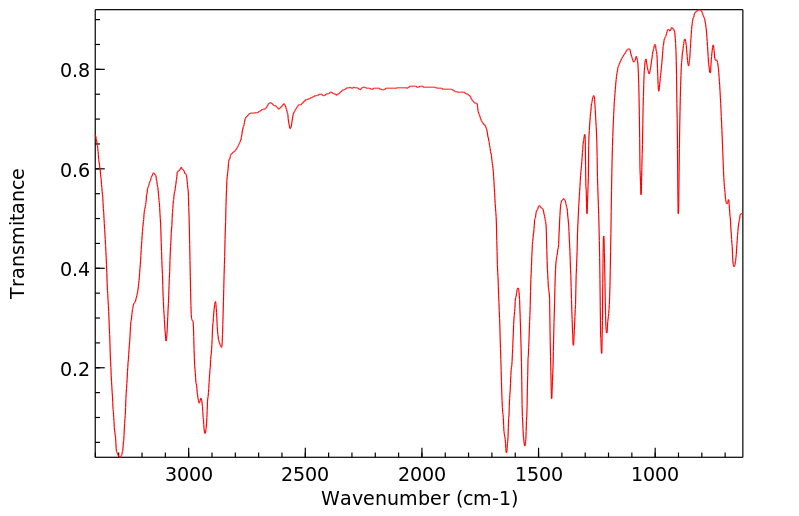N,N'-bis-(2-mercaptopropionyl)ethane-1,2-diamine | 687-72-9
中文名称
——
中文别名
——
英文名称
N,N'-bis-(2-mercaptopropionyl)ethane-1,2-diamine
英文别名
N,N'-ethylenebis(2-mercaptopropanamide);N,N-ethylenebis(2-mercaptopropionamide);N,N'-Ethylen-bis-(2-mercapto-propionamid);N,N'-Ethylenebis(2-mercaptopropionamide);2-sulfanyl-N-[2-(2-sulfanylpropanoylamino)ethyl]propanamide
CAS
687-72-9
化学式
C8H16N2O2S2
mdl
——
分子量
236.359
InChiKey
NQBOCGBWMCQBAA-UHFFFAOYSA-N
BEILSTEIN
——
EINECS
——
-
物化性质
-
计算性质
-
ADMET
-
安全信息
-
SDS
-
制备方法与用途
-
上下游信息
-
文献信息
-
表征谱图
-
同类化合物
-
相关功能分类
-
相关结构分类
计算性质
-
辛醇/水分配系数(LogP):0.3
-
重原子数:14
-
可旋转键数:5
-
环数:0.0
-
sp3杂化的碳原子比例:0.75
-
拓扑面积:60.2
-
氢给体数:4
-
氢受体数:4
反应信息
-
作为反应物:描述:ammonium pertechnetate 、 N,N'-bis-(2-mercaptopropionyl)ethane-1,2-diamine 、 对氯苯肼盐酸盐 、 四苯硼钠 以 甲醇 为溶剂, 以66%的产率得到参考文献:名称:Technetium diazenido-complexes. Part 2. Substitution chemistry of [TcCl(NNC6H4Cl-4)2(PPh3)2] and the synthesis of technetium diazenido-complexes directly from [NH4][TcO4]摘要:The bis(diazenido)technetium(III) complex [TcCl(NNR)2(PPh3)2] (R = C6H4Cl-4) reacted with bidentate ligands L with loss of one diazenide ligand to give [Tc(NNR)L2(PPh3)] (L = S2CNR2) and (TcCl(NNR)L(PPh3)2] (HL = maltol) in high yield. With dianionic tetradentate ligands L' complexes of the type cis-[Tc(NNR)L'(PPh3)] [L' = dianion of N,N'-bis(salicylidene)ethane-1,2-diamine (salen), S(CH2)2NMe(CH2)2NMe(CH2)2S or O2S(CH2)2NMe(CH2)2NMe(CH2)2SO2] were obtained. The crystal structure of the complex with L' = salen has been determined. It shows pseudo-octahedral co-ordination about the Tc with the NNR and PPh3 ligands cis. Direct reaction of [TcO4]- with arylhydrazine hydrochlorides generated a diazenide species in situ which reacts with S2CNR2 to give [TcCl(NNR)2(S2CNR2)2] and 2.2'-bipyridine (bipy) to give [TcCl(NNR)(bipy)2]+ isolated as a BPh4- salt.DOI:10.1039/dt9940001251
-
作为产物:参考文献:名称:Chain transfer agents for raft polymerization in aqueous media摘要:通过产生分子量范围较窄的方式合成的聚合物和共聚物可能具有与传统方式合成的聚合物不同的性质。然而,为了获得这种聚合物,必须控制聚合过程。一种控制聚合的类型是可逆加成-断裂链转移(RAFT)过程,具有类似活性聚合的特征。本发明揭示了一组二硫酸酯和三硫酸酯,适用作为RAFT聚合的链转移剂。本发明还揭示了在水性介质中进行的RAFT聚合过程。公开号:US06855840B2
文献信息
-
Chain transfer agents for RAFT polymerization in aqueous media申请人:McCormick L. Charles公开号:US20060111531A1公开(公告)日:2006-05-25Polymers and copolymers synthesized by means that yield a narrow range of molecular weights can have different properties than polymers synthesized by conventional means. In order to obtain such polymers, however, polymerization must be controlled. One type of controlled polymerization is the reversible addition-fragmentation chain transfer (RAFT) process, which has characteristics of a living polymerization. The present invention discloses a group of dithioesters and trithioesters suitable as chain transfer agents for RAFT polymerization. The present invention also discloses RAFT polymerizations conducted in aqueous media.
-
Potential Antiradiation Drugs. I. Amide, Hydroxamic Acid, and Hydrazine Derivatives of Mercapto Acids. Amino Thioacids<sup>1</sup>作者:Edward R. Atkinson、G. Richard Handrick、Robert J. Bruni、Felix E. GranchelliDOI:10.1021/jm00325a007日期:1965.1
-
Liao, Fen-Ling; Wang, Sue-Lein; Lin, Cheng-Hsien, Journal of the Chinese Chemical Society, 1994, vol. 41, # 5, p. 557 - 564作者:Liao, Fen-Ling、Wang, Sue-Lein、Lin, Cheng-Hsien、Huang, Shih-TsorngDOI:——日期:——
-
US6855840B2申请人:——公开号:US6855840B2公开(公告)日:2005-02-15
-
US7186786B2申请人:——公开号:US7186786B2公开(公告)日:2007-03-06
表征谱图
-
氢谱1HNMR
-
质谱MS
-
碳谱13CNMR
-
红外IR
-
拉曼Raman
-
峰位数据
-
峰位匹配
-
表征信息
同类化合物
(甲基3-(二甲基氨基)-2-苯基-2H-azirene-2-羧酸乙酯)
(±)-盐酸氯吡格雷
(±)-丙酰肉碱氯化物
(d(CH2)51,Tyr(Me)2,Arg8)-血管加压素
(S)-(+)-α-氨基-4-羧基-2-甲基苯乙酸
(S)-阿拉考特盐酸盐
(S)-赖诺普利-d5钠
(S)-2-氨基-5-氧代己酸,氢溴酸盐
(S)-2-[[[(1R,2R)-2-[[[3,5-双(叔丁基)-2-羟基苯基]亚甲基]氨基]环己基]硫脲基]-N-苄基-N,3,3-三甲基丁酰胺
(S)-2-[3-[(1R,2R)-2-(二丙基氨基)环己基]硫脲基]-N-异丙基-3,3-二甲基丁酰胺
(S)-1-(4-氨基氧基乙酰胺基苄基)乙二胺四乙酸
(S)-1-[N-[3-苯基-1-[(苯基甲氧基)羰基]丙基]-L-丙氨酰基]-L-脯氨酸
(R)-乙基N-甲酰基-N-(1-苯乙基)甘氨酸
(R)-丙酰肉碱-d3氯化物
(R)-4-N-Cbz-哌嗪-2-甲酸甲酯
(R)-3-氨基-2-苄基丙酸盐酸盐
(R)-1-(3-溴-2-甲基-1-氧丙基)-L-脯氨酸
(N-[(苄氧基)羰基]丙氨酰-N〜5〜-(diaminomethylidene)鸟氨酸)
(6-氯-2-吲哚基甲基)乙酰氨基丙二酸二乙酯
(4R)-N-亚硝基噻唑烷-4-羧酸
(3R)-1-噻-4-氮杂螺[4.4]壬烷-3-羧酸
(3-硝基-1H-1,2,4-三唑-1-基)乙酸乙酯
(2S,4R)-Boc-4-环己基-吡咯烷-2-羧酸
(2S,3S,5S)-2-氨基-3-羟基-1,6-二苯己烷-5-N-氨基甲酰基-L-缬氨酸
(2S,3S)-3-((S)-1-((1-(4-氟苯基)-1H-1,2,3-三唑-4-基)-甲基氨基)-1-氧-3-(噻唑-4-基)丙-2-基氨基甲酰基)-环氧乙烷-2-羧酸
(2S)-2,6-二氨基-N-[4-(5-氟-1,3-苯并噻唑-2-基)-2-甲基苯基]己酰胺二盐酸盐
(2S)-2-氨基-N,3,3-三甲基-N-(苯甲基)丁酰胺
(2S)-2-氨基-3-甲基-N-2-吡啶基丁酰胺
(2S)-2-氨基-3,3-二甲基-N-(苯基甲基)丁酰胺,
(2S)-2-氨基-3,3-二甲基-N-2-吡啶基丁酰胺
(2S,4R)-1-((S)-2-氨基-3,3-二甲基丁酰基)-4-羟基-N-(4-(4-甲基噻唑-5-基)苄基)吡咯烷-2-甲酰胺盐酸盐
(2R,3'S)苯那普利叔丁基酯d5
(2R)-2-氨基-3,3-二甲基-N-(苯甲基)丁酰胺
(2-氯丙烯基)草酰氯
(1S,3S,5S)-2-Boc-2-氮杂双环[3.1.0]己烷-3-羧酸
(1R,5R,6R)-5-(1-乙基丙氧基)-7-氧杂双环[4.1.0]庚-3-烯-3-羧酸乙基酯
(1R,4R,5S,6R)-4-氨基-2-氧杂双环[3.1.0]己烷-4,6-二羧酸
齐特巴坦
齐德巴坦钠盐
齐墩果-12-烯-28-酸,2,3-二羟基-,苯基甲基酯,(2a,3a)-
齐墩果-12-烯-28-酸,2,3-二羟基-,羧基甲基酯,(2a,3b)-(9CI)
黄酮-8-乙酸二甲氨基乙基酯
黄荧菌素
黄体生成激素释放激素(1-6)
黄体生成激素释放激素 (1-5) 酰肼
黄体瑞林
麦醇溶蛋白
麦角硫因
麦芽聚糖六乙酸酯
麦根酸







